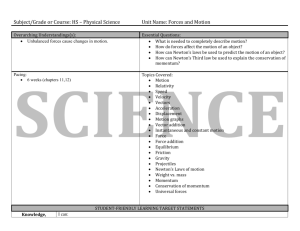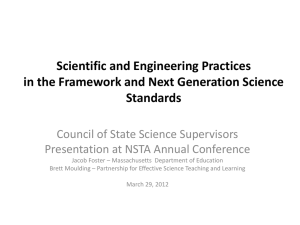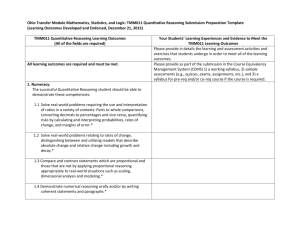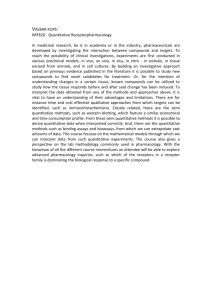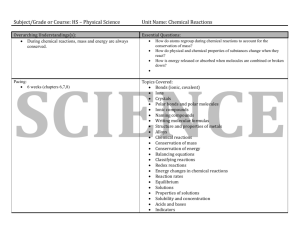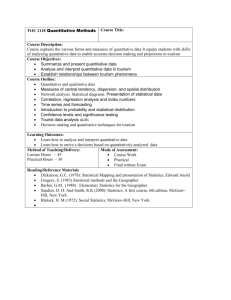SMU Physics
advertisement
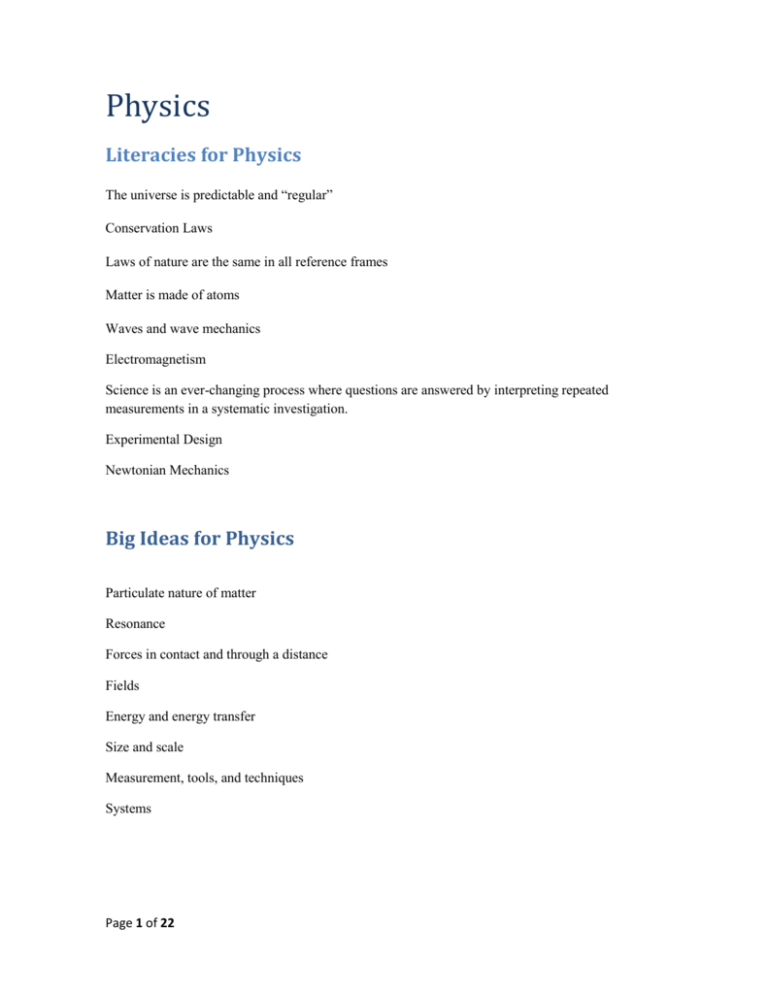
Physics Literacies for Physics The universe is predictable and “regular” Conservation Laws Laws of nature are the same in all reference frames Matter is made of atoms Waves and wave mechanics Electromagnetism Science is an ever-changing process where questions are answered by interpreting repeated measurements in a systematic investigation. Experimental Design Newtonian Mechanics Big Ideas for Physics Particulate nature of matter Resonance Forces in contact and through a distance Fields Energy and energy transfer Size and scale Measurement, tools, and techniques Systems Page 1 of 22 Primary Tenets in Science1 Reductionism – Science describes natural phenomena in terms of a small number of laws, which allow predictions to be made on whether and how things will happen. Universality The laws of science are universal – they work everywhere. Unification –There is a drive to reduce the number of laws to as small a number as possible, each one expressed in as economical a way as possible. Synoptic nature– Physics is an interlinked totality of ideas that must be consistent with each other. Problems can be approached from many different directions. Cause and effect– Events can be discussed and understood in terms of causes and effects: what makes things happen the way they do. Mathematical techniques – Physical laws can be expressed in a mathematical form. Scientists develop mathematical representations to describe and predict behavior. Conservation – Some quantities (charge, mass-energy, matter and momentum) are conserved. These conservation laws lead to powerful restrictions on behavior. Equilibrium – Equilibrium occurs when two or more external influences are in balance – balanced forces, balanced moments, balanced pressures, equal flows in and out. Differences cause change – For example, temperature difference, pressure difference, potential difference, differences in concentration and unbalanced forces. Inertia – Things will tend to stay as they are unless something causes them to change. Dissipation – Many processes have an element that is resistive and dissipative. Dissipation is a result of the tendency of a system to become more disordered. Irreversibility – Dissipative processes are irreversible. For example, they limit the usefulness and the lifetime of a resource and determine the arrow of time. Fields – Action at a distance is explained using the construct of fields. Energy – There is a useful accounting tool – energy – that allows us to do calculations to find out, for example, how long sources will last, or whether some events can happen. Multiple Representations of Models – Scientific models have multiple representations, including graphs, diagrams, equations, various charts (histograms, pie, etc.), and narrative descriptions. 1 Hunt, Andrew, et. al., Ideas and Evidence in Science: Lessons From Assessment, Final Report, SCORE, 2010. Page 2 of 22 Page 3 of 22 Primary Cultural Tenets in Science Safety Science is practiced by a community that includes collaboration and peer review. Science is an ever-changing process where questions are answered by interpreting repeated measurements in a systematic investigation. The scientific community extends to resources and contacts in the digital realm. Science is the search for the fundamental properties of nature; engineering is the application of these properties to structure, processing, and performance. Research and applications of knowledge have ethical implications. Technology Skills Use computational devices such as calculators and computers. Use spreadsheets to manipulate data and graph relationships. Use appropriate data acquisition equipment for collection and analysis of measurements. Use Internet search engines to locate valid course information. Locate, interact, and participate with course information utilizing various Internet-Based applications. Use changes in technology for observation and measurement to increase the range and types of questions that can be investigated. Page 4 of 22 Thinking Skills2 Critical thinking and skepticism – puzzling away at something and taking account of all possible objections to find an explanation that works Deep understanding – looking for deeper and deeper explanations, not being satisfied with a superficial description, looking for the most fundamental answer that has predictive power across many domains Seeking consistency – testing that answers are consistent with experience and all other areas of the discipline Using experiments to test ideas – refining models through the iterative sequence of: experiment → model → prediction → test Models – developing representations to create models (often mathematical) of systems to make predictions of their behavior in a variety of circumstances Correspondence Principle – If a new model is valid, it must account for the verified results of the old model in the region where both models apply. Reason and logic – striving for logical consistency within arguments Quantitative understanding – realizing that quantitative analysis is necessary for proper understanding Simplification – simplifying physical situations (components or aspects) to their core elements to enable the use of quantitative models to explain or predict phenomena Isolating – isolating physical phenomena to test ideas experimentally Approximation and other techniques – making back-of-the-envelope calculations to test the plausibility of ideas, using techniques that consider limiting or extreme cases Excising prejudice – being able to step outside immediate experience and accept explanations Correlation does not require causation. Risk Assessment – to make a decision about a particular risk, we need to take into account both its risks and benefits, to all constituencies involved. 2 Main, Peter, Thinking like a physicist: design criteria for a physics curriculum, School Science Review Volume 95 (Number 352), March 2014. pp46-52. Page 5 of 22 Practical Work 1. 2. 3. 4. 5. 6. Illustration and demonstration of science phenomena. Familiarization with basic apparatus and techniques. Data gathering and analysis. Introducing scientific methods. Designing a scientific investigation. Reporting an investigation. (Writing Literacy) Models in Physics 1. 2. 3. 4. 5. 6. 7. 8. 9. 10. 11. 12. 13. 14. 15. 16. Mechanical waves in one dimension and resonance. Longitudinal waves and sound. Conservative systems The bound state of fields. Wave Nature of Light Geometric Optics and Ray Model Resonance Kinetic Theory of Matter (States of matter, thermal energy) A particle moving with no net force. A particle moving in a straight line with a net force. Free Particle: Inertia and interactions. A particle moving in two dimensions with a central force. Field mapping and interactions. Particulate nature of matter. Systems and interactions of particles. Uniform circular motion. Page 6 of 22 Unit 1: Motion/Kinematics (10 days) ● ● ● ● Constant velocity, red car lab, constant motion math Constant acceleration--rolling up/down ramp Free fall Graphical analysis ***Note: differentiate more between Regulars/Introduction (cut out advanced topics like integration, etc.) and Honors (move faster through easier topics, red car, etc.) Students who demonstrate understanding can: HS-ETS1-1. Analyze a major global challenge to specify qualitative and quantitative criteria and constraints for solutions that account for societal needs and wants. HS-ETS1-2. Design a solution to a complex real-world problem by breaking it down into smaller, more manageable problems that can be solved through engineering. HS-ETS1-3. Evaluate a solution to a complex real-world problem based on prioritized criteria and trade-offs that account for a range of constraints, including cost, safety, reliability, and aesthetics as well as possible social, cultural, and environmental impacts. HS-ETS1-4. Use a computer simulation to model the impact of proposed solutions to a complex realworld problem with numerous criteria and constraints on interactions within and between systems relevant to the problem. ETS1.A: Defining and Delimiting Engineering Problems ● Criteria and constraints also include satisfying any requirements set by society, such as taking issues of risk mitigation into account, and they should be quantified to the extent possible and stated in such a way that one can tell if a given design meets them. (HSETS1-1) ● Humanity faces major global challenges today, such as the need for supplies of clean water and food or for energy sources that minimize pollution, which can be addressed through engineering. These global challenges also may have manifestations in local communities. (HS-ETS1-1) ETS1.B: Developing Possible Solutions ● When evaluating solutions, it is important to take into account a range of constraints, including cost, safety, reliability, and aesthetics, and to consider social, cultural, and environmental impacts. (HS-ETS1-3) ● Both physical models and computers can be used in various ways to aid in the engineering design process. Computers are useful for a variety of purposes, such as running simulations to test different ways of solving a problem or to see which one is most efficient or economical; and in making a persuasive presentation to a client about how a given design will meet his or her needs. (HS-ETS1-4) http://www.nap.edu/openbook.php?record_id=13165&page=206 Page 7 of 22 ETS1.C: Optimizing the Design Solution ● Criteria may need to be broken down into simpler ones that can be approached systematically, and decisions about the priority of certain criteria over others (trade-offs) may be needed. (HS-ETS1-2) http://www.nap.edu/openbook.php?record_id=13165&page=177 Page 8 of 22 Unit 2: Fields and Energy (10 days) ● ● ● ● ● ● ● ● What is a field? Drawing field lines Magnetic, then electric, then gravitational fields modeling Fg=mg lab, Hooke’s Law Energy conservations (pendulum lab) and transfers, heat Bar charts, flow diagrams Kinetic, gravitational, spring energy math Work and Power Students who demonstrate understanding can: PS2.B: Types of Interactions ● Forces at a distance are explained by fields (gravitational, electric, and magnetic) permeating space that can transfer energy through space. Magnets or electric currents cause magnetic fields; electric charges or changing magnetic fields cause electric fields. (HS-PS24),(HS-PS2-5) PS3.A: Definitions of Energy “Electrical energy” may mean energy stored in a battery or energy transmitted by electric currents. (secondary to HS-PS2-5) ● Energy is a quantitative property of a system that depends on the motion and interactions of matter and radiation within that system. That there is a single quantity called energy is due to the fact that a system’s total energy is conserved, even as, within the system, energy is continually transferred from one object to another and between its various possible forms. (HS-PS3-1), (HS-PS3-2) ● At the macroscopic scale, energy manifests itself in multiple ways, such as in motion, sound, light, and thermal energy. (HS-PS3-2) (HS-PS3-3) ● These relationships are better understood at the microscopic scale, at which all of the different manifestations of energy can be modeled as a combination of energy associated with the motion of particles and energy associated with the configuration (relative position of the particles). In some cases the relative position energy can be thought of as stored in fields (which mediate interactions between particles). This last concept includes radiation, a phenomenon in which energy stored in fields moves across space. (HS-PS3-2) PS3.B: Conservation of Energy and Energy Transfer ● Conservation of energy means that the total change of energy in any system is always equal to the total energy transferred into or out of the system. (HS-PS3-1) ● Energy cannot be created or destroyed, but it can be transported from one place to another and transferred between systems. (HS-PS3-1), (HS-PS3-4) ● Mathematical expressions, which quantify how the stored energy in a system depends on its configuration (e.g. relative positions of charged particles, compression of a spring) and how kinetic energy depends on mass and speed, allow the concept of conservation of energy to be used to predict and describe system behavior. (HS-PS3-1) ● The availability of energy limits what can occur in any system. (HS-PS3-1) http://www.nap.edu/openbook.php?record_id=13165&page=124 Page 9 of 22 PS3.C: Relationship Between Energy and Forces ● When two objects interacting through a field change relative position, the energy stored in the field is changed. (HS-PS3-5) PS3.D: Energy in Chemical Processes ● Although energy cannot be destroyed, it can be converted to less useful forms—for example, to thermal energy in the surrounding environment. (HS-PS3-3),(HS-PS3-4) http://www.nap.edu/openbook.php?record_id=13165&page=120 HS-ETS1-1. Analyze a major global challenge to specify qualitative and quantitative criteria and constraints for solutions that account for societal needs and wants. HS-ETS1-2. Design a solution to a complex real-world problem by breaking it down into smaller, more manageable problems that can be solved through engineering. HS-ETS1-3. Evaluate a solution to a complex real-world problem based on prioritized criteria and trade-offs that account for a range of constraints, including cost, safety, reliability, and aesthetics as well as possible social, cultural, and environmental impacts. HS-ETS1-4. Use a computer simulation to model the impact of proposed solutions to a complex realworld problem with numerous criteria and constraints on interactions within and between systems relevant to the problem. Page 10 of 22 Students who demonstrate understanding can: HS-PS3-1 Create a computational model to calculate the change in the energy of one component in a system when the change in energy of the other component(s) and energy flows in and out of the system are known. [Clarification Statement: Emphasis is on explaining the meaning of mathematical expressions used in the model.] [Assessment Boundary: Assessment is limited to basic algebraic expressions or computations; to systems of two or three components; and to thermal energy, kinetic energy, and/or the energies in gravitational, magnetic, or electric fields.] HS-PS3-2. Develop and use models to illustrate that energy at the macroscopic scale can be accounted for as a combination of energy associated with the motions of particles (objects) and energy associated with the relative positions of particles (objects). [Clarification Statement: Examples of phenomena at the macroscopic scale could include the conversion of kinetic energy to thermal energy, the energy stored due to position of an object above the earth, and the energy stored between two electrically-charged plates. Examples of models could include diagrams, drawings, descriptions, and computer simulations.] HS-PS3-3. Design, build, and refine a device that works within given constraints to convert one form of energy into another form of energy.* [Clarification Statement: Emphasis is on both qualitative and quantitative evaluations of devices. Examples of devices could include Rube Goldberg devices, wind turbines, solar cells, solar ovens, and generators. Examples of constraints could include use of renewable energy forms and efficiency.] [Assessment Boundary: Assessment for quantitative evaluations is limited to total output for a given input. Assessment is limited to devices constructed with materials provided to students.] HS-PS3-5. Develop and use a model of two objects interacting through electric or magnetic fields to illustrate the forces between objects and the changes in energy of the objects due to the interaction. [Clarification Statement: Examples of models could include drawings, diagrams, and texts, such as drawings of what happens when two charges of opposite polarity are near each other.] [Assessment Boundary: Assessment is limited to systems containing two objects.] Page 11 of 22 ETS1.A: Defining and Delimiting Engineering Problems ● Criteria and constraints also include satisfying any requirements set by society, such as taking issues of risk mitigation into account, and they should be quantified to the extent possible and stated in such a way that one can tell if a given design meets them. (HSETS1-1) ● Humanity faces major global challenges today, such as the need for supplies of clean water and food or for energy sources that minimize pollution, which can be addressed through engineering. These global challenges also may have manifestations in local communities. (HS-ETS1-1) ETS1.B: Developing Possible Solutions ● When evaluating solutions, it is important to take into account a range of constraints, including cost, safety, reliability, and aesthetics, and to consider social, cultural, and environmental impacts. (HS-ETS1-3) ● Both physical models and computers can be used in various ways to aid in the engineering design process. Computers are useful for a variety of purposes, such as running simulations to test different ways of solving a problem or to see which one is most efficient or economical; and in making a persuasive presentation to a client about how a given design will meet his or her needs. (HS-ETS1-4) http://www.nap.edu/openbook.php?record_id=13165&page=206 ETS1.C: Optimizing the Design Solution ● Criteria may need to be broken down into simpler ones that can be approached systematically, and decisions about the priority of certain criteria over others (trade-offs) may be needed. (HS-ETS1-2) http://www.nap.edu/openbook.php?record_id=13165&page=177 Page 12 of 22 Unit 3: Mechanics...possibly including (20 days) Forces ○ ○ ○ ○ Newton’s Laws Center of Mass Vectors and force diagrams Equilibrium on inclined planes, tensions, elevators Students who demonstrate understanding can: HS-PS2-1. Analyze data to support the claim that Newton’s second law of motion describes the mathematical relationship among the net force on a macroscopic object, its mass, and its acceleration. [Clarification Statement: Examples of data could include tables or graphs of position or velocity as a function of time for objects subject to a net unbalanced force, such as a falling object, an object rolling down a ramp, or a moving object being pulled by a constant force.] [Assessment Boundary: Assessment is limited to one-dimensional motion and to macroscopic objects moving at non-relativistic speeds.] HS-PS2-2. Use mathematical representations to support the claim that the total momentum of a system of objects is conserved when there is no net force on the system. [Clarification Statement: Emphasis is on the quantitative conservation of momentum in interactions and the qualitative meaning of this principle.] [Assessment Boundary: Assessment is limited to systems of two macroscopic bodies moving in one dimension.] PS2.A: Forces and Motion Newton’s second law accurately predicts changes in the motion of macroscopic objects. (HS-S2-1) Page 13 of 22 Unit 3: Mechanics . . . Continued Projectiles --as time allows ○ Ball in Cup engineering project Momentum ○ Single object p=mv ○ Impulse-momentum Ft=mΔv ○ Conservation of momentum within a system (elastic and/or inelastic depending on level) PS2.A: Forces and Motion http://www.nap.edu/openbook.php?record_id=13165&page=114 ● Momentum is defined for a particular frame of reference; it is the mass times the velocity of the object. (HS-PS2-2) ● If a system interacts with objects outside itself, the total momentum of the system can change; however, any such change is balanced by changes in the momentum of objects outside the system. (HS-PS2-2),(HS-PS2-3) HS-PS2-3. Page 14 of 22 Apply scientific and engineering ideas to design, evaluate, and refine a device that minimizes the force on a macroscopic object during a collision.* [Clarification Statement: Examples of evaluation and refinement could include determining the success of the device at protecting an object from damage and modifying the design to improve it. Examples of a device could include a football helmet or a parachute.] [Assessment Boundary: Assessment is limited to qualitative evaluations and/or algebraic manipulations.] Unit 3: Mechanics . . . Continued Circular motion ○ ○ ○ ○ HS-PS2-4. Centripetal force, acceleration Newton’s Law of Gravitation Kepler’s Laws Rotational and angular (??if time) Use mathematical representations of Newton’s Law of Gravitation and Coulomb’s Law to describe and predict the gravitational and electrostatic forces between objects. [Clarification Statement: Emphasis is on both quantitative and conceptual descriptions of gravitational and electric fields.] [Assessment Boundary: Assessment is limited to systems with two objects.] PS2.B: Types of Interactions ● Newton’s law of universal gravitation and Coulomb’s law provide the mathematical models to describe and predict the effects of gravitational and electrostatic forces between distant objects. (HS-PS2-4) The following Engineering Design objectives apply to all subunits of Unit 3: HS-ETS1-1. Analyze a major global challenge to specify qualitative and quantitative criteria and constraints for solutions that account for societal needs and wants. HS-ETS1-2. Design a solution to a complex real-world problem by breaking it down into smaller, more manageable problems that can be solved through engineering. HS-ETS1-3. Evaluate a solution to a complex real-world problem based on prioritized criteria and trade-offs that account for a range of constraints, including cost, safety, reliability, and aesthetics as well as possible social, cultural, and environmental impacts. HS-ETS1-4. Use a computer simulation to model the impact of proposed solutions to a complex realworld problem with numerous criteria and constraints on interactions within and between systems relevant to the problem. Page 15 of 22 ETS1.A: Defining and Delimiting Engineering Problems ● Criteria and constraints also include satisfying any requirements set by society, such as taking issues of risk mitigation into account, and they should be quantified to the extent possible and stated in such a way that one can tell if a given design meets them. (HSETS1-1) ● Humanity faces major global challenges today, such as the need for supplies of clean water and food or for energy sources that minimize pollution, which can be addressed through engineering. These global challenges also may have manifestations in local communities. (HS-ETS1-1) ETS1.B: Developing Possible Solutions ● When evaluating solutions, it is important to take into account a range of constraints, including cost, safety, reliability, and aesthetics, and to consider social, cultural, and environmental impacts. (HS-ETS1-3) Both physical models and computers can be used in various ways to aid in the engineering design process. Computers are useful for a variety of purposes, such as running simulations to test different ways of solving a problem or to see which one is most efficient or economical; and in making a persuasive presentation to a client about how a given design will meet his or her needs. (HS-ETS1-4) http://www.nap.edu/openbook.php?record_id=13165&page=206 ● ETS1.C: Optimizing the Design Solution ● Criteria may need to be broken down into simpler ones that can be approached systematically, and decisions about the priority of certain criteria over others (trade-offs) may be needed. (HS-ETS1-2) http://www.nap.edu/openbook.php?record_id=13165&page=177 Page 16 of 22 Unit 4: Electricity and Magnetism (20 days) ● ● ● ● ● ● ● Review E field parallel plate (baking dish lab). Insulators and conductors, electrostatics, Coulomb’s Law Circuits, Ohm’s Law, batteries Series versus parallel (as time permits) Capacitors Magnetism and induction Motor: engineering and design Students who demonstrate understanding can: HS-PS2-4. Use mathematical representations of Newton’s Law of Gravitation and Coulomb’s Law to describe and predict the gravitational and electrostatic forces between objects. [Clarification Statement: Emphasis is on both quantitative and conceptual descriptions of gravitational and electric fields.] [Assessment Boundary: Assessment is limited to systems with two objects.] HS-PS2-5. Plan and conduct an investigation to provide evidence that an electric current can produce a magnetic field and that a changing magnetic field can produce an electric current. [Assessment Boundary: Assessment is limited to designing and conducting investigations with provided materials and tools.] HS-PS2-6. Communicate scientific and technical information about why the molecular-level structure is important in the functioning of designed materials.* [Clarification Statement: Emphasis is on the attractive and repulsive forces that determine the functioning of the material. Examples could include why electrically conductive materials are often made of metal, flexible but durable materials are made up of long chained molecules, and pharmaceuticals are designed to interact with specific receptors.] [Assessment Boundary: Assessment is limited to provided molecular structures of specific designed materials.] PS2.B: Types of Interactions ● Newton’s law of universal gravitation and Coulomb’s law provide the mathematical models to describe and predict the effects of gravitational and electrostatic forces between distant objects. (HS-PS2-4) ● Forces at a distance are explained by fields (gravitational, electric, and magnetic) permeating space that can transfer energy through space. Magnets or electric currents cause magnetic fields; electric charges or changing magnetic fields cause electric fields. (HS-PS2-4), (HS-PS2-5) Page 17 of 22 PS3.A: Definitions of Energy ● “Electrical energy” may mean energy stored in a battery or energy transmitted by electric currents.(secondary to HS-PS2-5) PS3.C: Relationship Between Energy and Forces ● When two objects interacting through a field change relative position, the energy stored in the field is changed. (HS-PS3-5) HS-PS3-2. Develop and use models to illustrate that energy at the macroscopic scale can be accounted for as a combination of energy associated with the motions of particles (objects) and energy associated with the relative positions of particles (objects). [Clarification Statement: Examples of phenomena at the macroscopic scale could include the conversion of kinetic energy to thermal energy, the energy stored due to position of an object above the earth, and the energy stored between two electrically-charged plates. Examples of models could include diagrams, drawings, descriptions, and computer simulations.] HS-PS3-3. Design, build, and refine a device that works within given constraints to convert one form of energy into another form of energy.* [Clarification Statement: Emphasis is on both qualitative and quantitative evaluations of devices. Examples of devices could include Rube Goldberg devices, wind turbines, solar cells, solar ovens, and generators. Examples of constraints could include use of renewable energy forms and efficiency.] [Assessment Boundary: Assessment for quantitative evaluations is limited to total output for a given input. Assessment is limited to devices constructed with materials provided to students.] HS-PS3-5. Develop and use a model of two objects interacting through electric or magnetic fields to illustrate the forces between objects and the changes in energy of the objects due to the interaction. [Clarification Statement: Examples of models could include drawings, diagrams, and texts, such as drawings of what happens when two charges of opposite polarity are near each other.] [Assessment Boundary: Assessment is limited to systems containing two objects.] Page 18 of 22 HS-ETS1-1. Analyze a major global challenge to specify qualitative and quantitative criteria and constraints for solutions that account for societal needs and wants. HS-ETS1-2. Design a solution to a complex real-world problem by breaking it down into smaller, more manageable problems that can be solved through engineering. HS-ETS1-3. Evaluate a solution to a complex real-world problem based on prioritized criteria and tradeoffs that account for a range of constraints, including cost, safety, reliability, and aesthetics as well as possible social, cultural, and environmental impacts. HS-ETS1-4. Use a computer simulation to model the impact of proposed solutions to a complex real-world problem with numerous criteria and constraints on interactions within and between systems relevant to the problem. ETS1.A: Defining and Delimiting Engineering Problems ● Criteria and constraints also include satisfying any requirements set by society, such as taking issues of risk mitigation into account, and they should be quantified to the extent possible and stated in such a way that one can tell if a given design meets them. (HSETS1-1) ● Humanity faces major global challenges today, such as the need for supplies of clean water and food or for energy sources that minimize pollution, which can be addressed through engineering. These global challenges also may have manifestations in local communities. (HS-ETS1-1) ETS1.B: Developing Possible Solutions ● When evaluating solutions, it is important to take into account a range of constraints, including cost, safety, reliability, and aesthetics, and to consider social, cultural, and environmental impacts. (HS-ETS1-3) ● Both physical models and computers can be used in various ways to aid in the engineering design process. Computers are useful for a variety of purposes, such as running simulations to test different ways of solving a problem or to see which one is most efficient or economical; and in making a persuasive presentation to a client about how a given design will meet his or her needs. (HS-ETS1-4) http://www.nap.edu/openbook.php?record_id=13165&page=206 ETS1.C: Optimizing the Design Solution ● Criteria may need to be broken down into simpler ones that can be approached systematically, and decisions about the priority of certain criteria over others (trade-offs) may be needed. (HS-ETS1-2) http://www.nap.edu/openbook.php?record_id=13165&page=177 Page 19 of 22 Unit 5: Waves, sound, light, color, optics (20 days) ● ● ● ● ● ● ● ● Wave basics, interference, sound, resonance, Doppler effect, sonic boom EM spectrum, polarization, color Wave equation Wave/particle duality, photoelectric effect Digital transmission and storage Optics, reflection, refraction Fiber optics, communication and medical technology Speed of light video Students who demonstrate understanding can: PS3.A: Definitions of Energy http://www.nap.edu/openbook.php?record_id=13165&page=120 ● At the macroscopic scale, energy manifests itself in multiple ways, such as in motion, sound, light, and thermal energy. (HS-PS3-2) (HS-PS3-3) ● These relationships are better understood at the microscopic scale, at which all of the different manifestations of energy can be modeled as a combination of energy associated with the motion of particles and energy associated with the configuration (relative position of the particles). In some cases the relative position energy can be thought of as stored in fields (which mediate interactions between particles). This last concept includes radiation, a phenomenon in which energy stored in fields moves across space. (HS-PS3-2) HS-PS4-1. Use mathematical representations to support a claim regarding relationships among the frequency, wavelength, and speed of waves traveling in various media. [Clarification Statement: Examples of data could include electromagnetic radiation traveling in a vacuum and glass, sound waves traveling through air and water, and seismic waves traveling through the Earth.] [Assessment Boundary: Assessment is limited to algebraic relationships and describing those relationships qualitatively.] HS-PS4-2. Evaluate questions about the advantages of using a digital transmission and storage of information. [Clarification Statement: Examples of advantages could include that digital information is stable because it can be stored reliably incomputer memory, transferred easily, and copied and shared rapidly. Disadvantages could include issues of easy deletion, security, and theft.] HS-PS4-3. Evaluate the claims, evidence, and reasoning behind the idea that electromagnetic radiation can be described either by a wave model or a particle model, and that for some situations one model is more useful than the other. [Clarification Statement: Emphasis is on how the experimental evidence supports the claim and how a theory is generally modified in light of new evidence. Examples of a phenomenon could include resonance, interference, diffraction, and photoelectric effect.] [Assessment Boundary: Page 20 of 22 Assessment does not include using quantum theory.] HS-PS4-4. Evaluate the validity and reliability of claims in published materials of the effects that different frequencies of electromagnetic radiation have when absorbed by matter. [Clarification Statement: Emphasis is on the idea that photons associated with different frequencies of light have different energies, and the damage to living tissue from electromagnetic radiation depends on the energy of the radiation. Examples of published materials could include trade books, magazines, web resources, videos, and other passages that may reflect bias.] [Assessment Boundary: Assessment is limited to qualitative descriptions.] HS-PS4-5. Communicate technical information about how some technological devices use the principles of wave behavior and wave interactions with matter to transmit and capture information and energy.* [Clarification Statement: Examples could include solar cells capturing light and converting it to electricity; medical imaging; and communications technology.] [Assessment Boundary: Assessments are limited to qualitative information. Assessments do not include band theory.] PS4.A: Wave Properties ● The wavelength and frequency of a wave are related to one another by the speed of travel of the wave, which depends on the type of wave and the medium through which it is passing. (HS-PS4-1) ● Information can be digitized (e.g., a picture stored as the values of an array of pixels); in this form, it can be stored reliably in computer memory and sent over long distances as a series of wave pulses. (HS-PS4-2),(HS-PS4-5) ● [From the 3–5 grade band endpoints] Waves can add or cancel one another as they cross, depending on their relative phase (i.e., relative position of peaks and troughs of the waves), but they emerge unaffected by each other. (Boundary: The discussion at this grade level is qualitative only; it can be based on the fact that two different sounds can pass a location in different directions without getting mixed up.) (HS-PS4-3) PS4.B: Electromagnetic Radiation ● Electromagnetic radiation (e.g., radio, microwaves, light) can be modeled as a wave of changing electric and magnetic fields or as particles called photons. The wave model is useful for explaining many features of electromagnetic radiation, and the particle model explains other features. (HS-PS4-3) ● When light or longer wavelength electromagnetic radiation is absorbed in matter, it is generally converted into thermal energy (heat). Shorter wavelength electromagnetic radiation (ultraviolet, X-rays, gamma rays) can ionize atoms and cause damage to living cells. (HS-PS4-4) ● Photoelectric materials emit electrons when they absorb light of a high-enough frequency. (HS-PS4-5) PS4.C: Information Technologies and Instrumentation ● Multiple technologies based on the understanding of waves and their interactions with matter are part of everyday experiences in the modern world (e.g., medical imaging, Page 21 of 22 communications, scanners) and in scientific research. They are essential tools for producing, transmitting, and capturing signals and for storing and interpreting the information contained in them. (HS-PS4-5) HS-ETS1-1. Analyze a major global challenge to specify qualitative and quantitative criteria and constraints for solutions that account for societal needs and wants. HS-ETS1-2. Design a solution to a complex real-world problem by breaking it down into smaller, more manageable problems that can be solved through engineering. HS-ETS1-3. Evaluate a solution to a complex real-world problem based on prioritized criteria and trade-offs that account for a range of constraints, including cost, safety, reliability, and aesthetics as well as possible social, cultural, and environmental impacts. HS-ETS1-4. Use a computer simulation to model the impact of proposed solutions to a complex real-world problem with numerous criteria and constraints on interactions within and between systems relevant to the problem. http://www.nap.edu/openbook.php?record_id=13165&page=177 ETS1.A: Defining and Delimiting Engineering Problems ● Criteria and constraints also include satisfying any requirements set by society, such as taking issues of risk mitigation into account, and they should be quantified to the extent possible and stated in such a way that one can tell if a given design meets them. (HSETS1-1) ● Humanity faces major global challenges today, such as the need for supplies of clean water and food or for energy sources that minimize pollution, which can be addressed through engineering. These global challenges also may have manifestations in local communities. (HS-ETS1-1) ETS1.B: Developing Possible Solutions ● When evaluating solutions, it is important to take into account a range of constraints, including cost, safety, reliability, and aesthetics, and to consider social, cultural, and environmental impacts. (HS-ETS1-3) ● Both physical models and computers can be used in various ways to aid in the engineering design process. Computers are useful for a variety of purposes, such as running simulations to test different ways of solving a problem or to see which one is most efficient or economical; and in making a persuasive presentation to a client about how a given design will meet his or her needs. (HS-ETS1-4) http://www.nap.edu/openbook.php?record_id=13165&page=206 ETS1.C: Optimizing the Design Solution ● Criteria may need to be broken down into simpler ones that can be approached systematically, and decisions about the priority of certain criteria over others (trade-offs) may be needed. (HS-ETS1-2) Page 22 of 22
